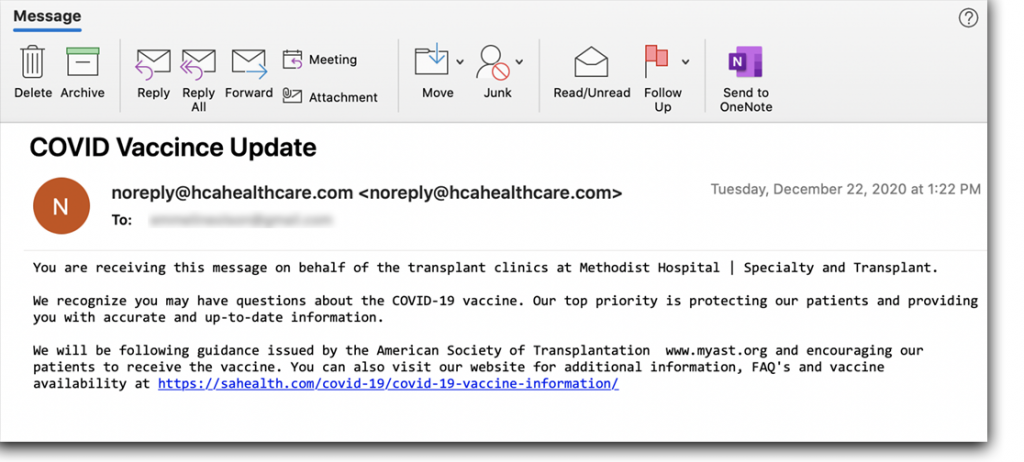First in a series.
On Dec. 11, after I had spent more than 80% of 2020 at home, the door to normalcy cracked open. That day, the U.S. Food and Drug Administration authorized the Pfizer-BioNTech COVID-19 vaccine for emergency use.
Being an immunocompromised transplant patient with Crohn’s, I fall into Phase 1C, as defined by the U.S. Centers for Disease Control and Prevention (CDC). This group includes people ages 16 to 64 with underlying medical conditions and comorbidities, such as inflammatory bowel disease (IBD), that could become life-threatening with COVID-19.
I would have to wait in line behind healthcare and frontline workers, as well as people older than 75 or living in long-term care facilities. Unexpectedly, I quickly moved to the front of the line. But I never imagined, nor was I prepared for, the difficulty of navigating the vaccination process in the U.S.
Eager but cautious
I expected to wait weeks or even months for Phases 1a and 1b to receive the initial doses. Because none of the vaccine trials included transplant patients, I didn’t mind the delay. Although I decided to get the shot, I remained alert for reports of side effects that could jeopardize my health.
The Crohn’s and Colitis Foundation announced its support of safe and effective COVID-19 vaccinations, but left the decision to individual patients and providers. After discovering that my gastroenterologist’s practice favored inoculation, my anxiety subsided. While my Crohn’s wouldn’t be an obstacle, I still had concerns as a transplant recipient.
Then, on Dec. 22, my transplant hospital decided to follow the American Society of Transplantation guidance to vaccinate pre- and post-transplant patients. The benefits of immunity to COVID-19 outweighed the possible risks of the vaccine. With the green light from my team, I eagerly anticipated my turn.

I didn’t wait long. On Dec. 23, Gov. Greg Abbott announced that Texas would break from the CDC vaccination guidelines. Texas Health and Human Services moved transplant patients into Phase 1B. The governor ordered immediate allocation to my group, which was easier said than done.
Looking for a needle in the haystack
After hearing the governor’s decree, I attempted to schedule an appointment with my primary care physician through the Austin Regional Clinic website. I was wrong to assume that getting the COVID-19 vaccine would be similar to scheduling my annual flu shot.
The COVID-19 vaccination scheduling page stated that the clinic was inoculating everyone, regardless of patient status. I had high hopes that as an established patient for more than 20 years, I wouldn’t have trouble getting on the waitlist.
I couldn’t even get past the first question: Are you a member of Phase 1A? My negative answer resulted in a message saying the clinic was only scheduling healthcare personnel per CDC guidelines.
I was optimistic that the page didn’t reflect the governor’s orders to include Phase 1B. As I predicted, the page was under maintenance later that night.
When the updated page came back online a few days later, the first question hadn’t changed. However, after I answered, two 1B-related questions populated: Was I over age 64, and did I have an underlying medical condition? I felt the vaccine was in reach when the last question asked if I had been to the clinic within the last three years.
I had my physical in October, so I expected my affirmative answer to take me to a sign-up page. Instead, I received a message that based on my health risks on record, the clinic would notify me through the patient portal after it vaccinated staff and other members of Phase 1A.
As I continued checking the site each morning for updates, I searched for vaccine availability at my transplant hospital, other providers, and local pharmacies. None offered the vaccine to the general public until they had served all members of group 1A.
COVID-19 vaccination rollout snafu
After a week and a half of being unable to find an appointment or a waitlist for the vaccine, I resigned myself to the fact that I would have to wait for my primary care physician to contact me. Those hopes were shattered when I read how the Austin Regional Clinic had vaccinated several people outside of groups 1A and 1B.
On Jan. 2, with several doses nearing expiration, the vaccine clinic turned into a first-come, first-served operation. Through word of mouth, everybody who showed up received the vaccine, regardless of need or patient status.
My anger turned into despair when, a few days later, the clinic replaced the waitlist questions on its COVID-19 vaccine page with a message in red. The clinic was out of doses, and it wasn’t expecting the state to replenish its supply. It urged patients to look elsewhere.
I had exhausted all of my options. Frustrated, I was close to giving up.
Next week, my joy of getting vaccinated is cut short when I discover the lengths people will go to find the vaccine.
***
Note: IBD News Today is strictly a news and information website about the disease. It does not provide medical advice, diagnosis, or treatment. This content is not intended to be a substitute for professional medical advice, diagnosis, or treatment. Always seek the advice of your physician or other qualified health providers with any questions you may have regarding a medical condition. Never disregard professional medical advice or delay in seeking it because of something you have read on this website. The opinions expressed in this column are not those of IBD News Today, or its parent company, BioNews, and are intended to spark discussion about issues pertaining to IBD.

